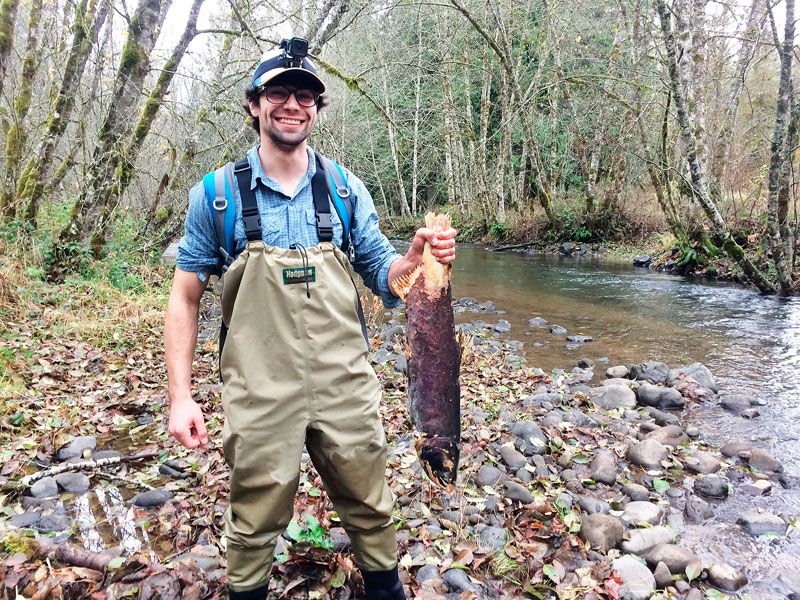
Submitted photo ##Oregon State University graduate Andrew Chione, a Native Fish Society river steward in the Yamhill Watershed, holds up a coho salmon carcass found on the Upper North Yamhill River.
Guest writer Luke Westphal serves as executive director of the nonprofit Greater Yamhill Watershed Council, where he joined the staff in 2012. He works with local stakeholders to develop projects and forge partnerships for healthy land, water and fish and wildlife habitat in the Yamhill and Chehalem valleys. He was assisted in developing today’s package by Jim LeTourneux, a veteran collaborator in habitat projects. A fourth-generation Oregonian, LeTourneux owns and manages the 460-acre Tripletree Timber holdings north of Sheridan at the upper end of Gopher Valley.
What hides beneath the roaring currents of the Yamhill River and its tributaries might surprise you.
These local streams are teeming with cold-water, anadromous fish — thousands of juvenile salmon, trout, and lamprey awaiting an instinctive call to journey 270 miles ocean-bound. After years roaming the Pacific, they will be beckoned back home again, to lay their eggs within the natal waters of the Yamhill Watershed and ultimately contribute their own bodies to sustain this aquatic life cycle.
The local shining star among these is the coho salmon. Coho are the most abundant ocean-bound fish in our watershed, with more than 250 miles of stream designated for their habitat.
You’re likely to find coho in a majority of the named tributaries across the Yamhill Watershed, and even among the most unassuming ditches and canals. To better understand these distributions, staff and volunteers with the Greater Yamhill Watershed Council have spent 10 years GPS-documenting observations of spawning coho, and have identified many miles of stream not previously designated as coho habitat.
Currently, Upper Willamette Coho are considered a non-native but naturalized fish species, as it is believed seasonal conditions at Willamette Falls would have historically prevented migration of spawning runs before a fish ladder was installed in the 1880s.
Coho hatchery stocking programs ran from 1954 until the 1980s, as the population was not expected to survive on its own. These planted stocks have somehow persisted over time and mixed with the wild population, creating a genetically unique naturalized Upper Willamette Coho.
In fact, this coho population has exploded over the last decade, with more than 20,000 coho moving on past Willamette Falls multiple years. Studies have shown the Yamhill Watershed is one of the largest producers of this run and may receive more than 45% of all of Upper Willamette Coho returning every year.
The underdog of the Yamhill Watershed is a small but resilient population of Upper-Willamette Winter Steelhead Trout. Studies have shown the Yamhill River is the largest winter steelhead producer of the coast-range tributaries draining into the Willamette River.
This species is considered native, and has been designated as threatened under the Endangered Species Act since 1999. In 2017, a historic-low return of 822 passed Willamette Falls, so its long-term survival remains uncertain.
As an ESA-listed species, more funding opportunities are available for projects to improve its habitat. These funds enable local landowners to cost-share with conservation agencies on voluntary projects that improve fish habitat, such as replacement of failing culverts hindering steelhead migration.
Last but not least is the most mysterious of our local ocean-bound fish, the Pacific Lamprey.
Often referred to as an “eel,” the Pacific Lamprey is a native, jawless, parasitic fish. Studies have shown the Yamhill Watershed is an important producer of Pacific Lamprey within the Upper-Willamette.
Until recently, little was known about where they were distributed across the Yamhill Watershed.
To learn more, watershed council staff and volunteers collected environmental DNA samples from local streams. This indicated Pacific Lamprey were widely distributed across the Watershed, inhabiting most major tributaries and even some small, unnamed drainage ways.
Water quality is a priority factor for the health of local fish populations. One of the most important ways to improve water quality is to establish a buffer strip of native plants alongside waterways, to provide shade on the stream and filter pollutants.
It’s common to hear of the need for such waterway vegetation buffers.
However, their size and composition may depend on your water quality goal. For example, one study showed that a buffer width of 15 meters, about 50 feet, reduced harmful toxins 2.5 times more than an 8 meter buffer, about 26 feet.
These 15-meter riparian buffers also provide higher dissolved oxygen and organic carbon levels within streams. Depending on the stream and adjacent land use, the composition of the vegetation will vary, but typically include a healthy mix of shrubs, grasses and trees.
While the Yamhill Watershed does not have any large dams limiting migration, as many other rivers do, studies have shown failing culverts are preventing fish migration to more than 100 miles of stream habitat. During low summer flows, juvenile fish are trapped on the downstream end of perched culverts, unable to jump the outlet gap to access colder, higher-quality waters above.
Some culverts blocking juvenile fish may still prove passable for adults, as they can make greater leaps. But the progeny of those fish will eventually feel the effects.
Most of the Yamhill Watershed is under private landownership, and thoughtful management of these lands has a significant impact on the health of our waterways.
If you have a waterway on your property, and would like to learn more about funding for or technical assistance with land management and stream habitat, please feel free to contact the Greater Yamhill Watershed Council at 503-474-1047 or info@gywc.org, or visit www.gywc.org/fish.
"fish" - Google News
February 05, 2022 at 03:45AM
https://ift.tt/RXo6971
Westphal & LeTourneux: To the Pacific and back: a Yamhill River fish tale - McMinnville News-Register
"fish" - Google News
https://ift.tt/kmyKPsh
https://ift.tt/azLnbWT
Bagikan Berita Ini














0 Response to "Westphal & LeTourneux: To the Pacific and back: a Yamhill River fish tale - McMinnville News-Register"
Post a Comment